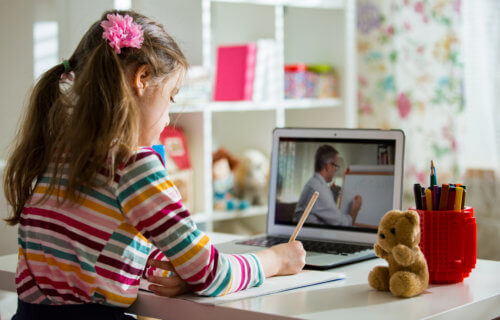ATLANTA, Ga. — During the coronavirus pandemic, the Centers for Disease Control and Prevention (CDC) has been the information source many Americans trust the most. The agency now has a new message for parents and school districts alike — get kids back in classrooms now. A new CDC report finds virtual learning is more damaging for a child’s mental health than in-person instruction. Along with their findings, officials also rolled out new safety guidance they say will help schools “open and remain open.”
In a CDC survey of over 1,200 parents with children between five and 12 yeas-old, researchers reveal students only learning virtually during COVID score worse in terms of physical and mental well-being. Virtual learners and their parents had noticeably higher scores on 11 of 17 stress indictors. These measure everything from child mental health, to physical activity levels, to parental emotional distress.
Of the 1,290 respondents between Oct. 8 and Nov. 13, 2020, nearly half (45.7%) said their kids were only learning online. Just under 31 percent were back attending in-person classes and 23.4 percent of students had a mix of the two. Additionally, the vast majority of respondents (92.9%) said their children attend public schools.
There is no substitute for going to school
The parent survey reveals children who only attend class virtually are more isolated, less active, and in a poorer emotional state than kids who are back in class or using “blended” learning. In fact, 62.9% of these parents say their child experienced decreased physical activity, compared to just 30.3 percent of parents with children back in class.
Scores for time spent outside (58% versus 27.4%), in-person time with friends (86.2% versus 69.5%), virtual time with friends (24.3% versus 12.6%), and worse mental or emotional health (24.9% versus 15.9%) all showed severe disparities between virtual and in-person learning.
Parents with children participating in blended learning report only slightly better results in comparison to virtual learners.
“Parents of children receiving in-person instruction reported the lowest prevalence of negative indicators of child and parental well-being. Children receiving virtual or combined instruction and their parents might need additional support to mitigate stress,” CDC researchers write.
The report finds children aren’t the only ones struggling when local school districts shut their doors. Researchers discovered parents of virtual learners are more likely to be dealing with several stressful situations during COVID as well. Over four in 10 reported losing work, 26.6 percent had job stability concerns, and 13.5 percent faced child care challenges.
New guidelines to open schools and keep them open
CDC officials are also easing up on the strict guidelines for public safety in school buildings. Along with the report, the agency updated their recommendations regarding social distancing among students.
The CDC now says three feet of space between children wearing face masks is enough while in school. Officials still say these buildings should be instituting a full mask mandate, but six feet of space in not necessary for elementary, middle, and high school classrooms. The agency does recommend more social distancing in large areas like lobbies, auditoriums, and cafeterias.
“CDC is committed to leading with science and updating our guidance as new evidence emerges,” says CDC Director Rochelle P. Walensky in a media release. “Safe in-person instruction gives our kids access to critical social and mental health services that prepare them for the future, in addition to the education they need to succeed. These updated recommendations provide the evidence-based roadmap to help schools reopen safely, and remain open, for in-person instruction.”
The new recommendations come after previous studies discovered social distancing policies in Massachusetts schools were likely too strict. Researchers discovered six feet of social distancing is simply not feasible for many buildings which don’t have that much space.
“Given the crucial services schools offer and the benefits of in-person learning, it is critical for K–12 schools to open and remain open for in-person instruction, as safely and as soon as possible,” the CDC concludes. “Schools should be the last settings to close because of COVID-19 and the first to reopen when they can do so safely.”
